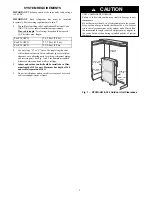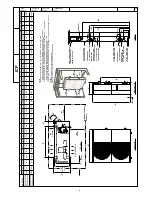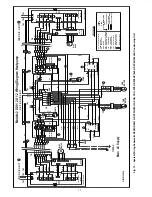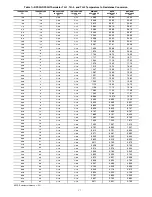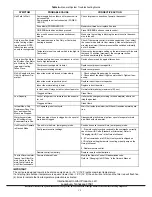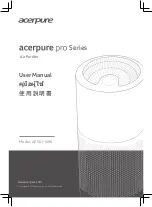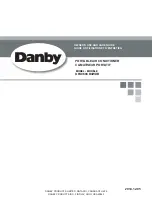
14
START
−
UP
System Checks
1. Conceal the tubing where possible.
2. Make sure that the drainage tube slopes downward along
its entire length.
3. Ensure all tubing and connections are properly insulated.
4. Fasten tubes to the outside wall.
5. Seal the hole through which the cables and tubing pass.
6. Connect the air conditioner to the power source and turn it
on.
7. Check all air conditioner operating modes. Refer to Own-
er’s Manual for operating details.
INDOOR UNIT
1. Do all the remote controller buttons function properly?
2. Do the display panel lights work properly?
3. Does the air deflection louver function properly?
4. Does the drainage work?
OUTDOOR UNIT
1. Are there unusual noises or vibrations during operation?
2. Is noise, drain water or airflow from the unit likely to dis-
turb the neighbors?
3. Are there any gas leaks?
EXPLAIN THE FOLLOWING ITEMS TO THE CUSTOMER,
WITH THE AID OF THE OWNER’S MANUAL:
1. How to turn the air conditioner on and off; selecting cool-
ing, heating and other operating modes; setting a desired
temperature; setting the timer to automatically start and
stop air conditioner operation; and the other features of the
remote controller and display panel.
2. How to remove and clean the air filter.
3. How to set the air deflection louver.
4. Explain care and maintenance.
5. Present the Owner’s Manual and installation instructions
to the customer.
CARE AND MAINTENANCE
The following may be performed by the equipment owner.
Outdoor Units
ELECTRICAL SHOCK HAZARD
Failure to follow this warning could result in personal
injury or death.
Before performing recommended maintenance, be sure unit
main power switch is turned off.
!
WARNING
CLEANING COILS — Coil should be washed out with
water or blown out with compressed air. Clean coil annu-
ally or as required by location and outdoor air condi-
tions. Inspect coil monthly and clean as required. Fins
are not continuous through coil sections. Dirt and debris
may pass through first section, become trapped between
the row of fins and restrict outdoor unit airflow. Use a
flashlight to determine if dirt or debris has collected be-
tween coil sections. Clean coil as follows:
1. Turn off unit power and install lockout tag.
2. Using a garden hose or other suitable equipment, flush
coil from the outside to remove dirt. Be sure to flush all
dirt and debris from drain holes in base of unit. Fan mo-
tors are waterproof.
Indoor Units
ELECTRICAL SHOCK HAZARD
Failure to follow this warning could result in personal
injury or death.
To avoid the possibility of electric shock, before performing
any cleaning and maintenance operations, always turn off
power to the system by pressing the ON/OFF button on the
remote control and turn off the separate disconnect switch
located near the unit.
If the indoor unit is on a separate switch, be sure to turn this
disconnect off as well.
WARNING
!
COMPONENT DAMAGE HAZARD
Failure to follow this may result in unit component damage.
Do not wash filter in water over 120
_
F (to avoid
shrinkage). Do not expose filter to fire (to avoid fire
damage). Do not expose filter to direct sunlight. Clean filter
more frequently when air is extremely dirty.
CAUTION
!
ELECTRICAL SHOCK, FIRE COMPONENT DAMAGE
HAZARD
Failure to follow this warning could result in personal
injury, death and or property damage.
Do not attempt to clean or service components in control
box.
WARNING
!
To Clean the Indoor Unit Front Panel
— if the front panel of
the unit becomes dirty or smudged, wipe the out
−
side of the panel
with a soft dry cloth. Use a mild liquid deter
−
gent and wipe off
carefully with a dry cloth.
To Clean Indoor Coil
— To clean the coil, remove indoor unit
front panel and vacuum the coil fins, using care not to bend or
damage fins.
LUBRICATION — The indoor
−
fan, automatic air sweep, and the
outdoor
−
fan motors are factory lubricated and require no oiling.
Air Filters for Indoor Units
COMPONENT DAMAGE HAZARD
Failure to follow this caution may result in unit component
damage.
Operating your system with dirty air filters may damage the
indoor unit and, in addition, can cause reduced
performance, intermittent system operation, frost build up
on the indoor coil, and blown fuses. Inspect and clean or
replace the air filters monthly.
CAUTION
!
TO REMOVE AIR FILTERS — Open the unit’s front panel by
lifting the lower part and pulling it gently outward and upward.
Pull out the filters.
TO CLEAN OR REPLACE FILTERS — Filters can be
vacuumed or washed in warm water. Shake filter to remove any
excess water, and replace it back. If the filter has begun to break


